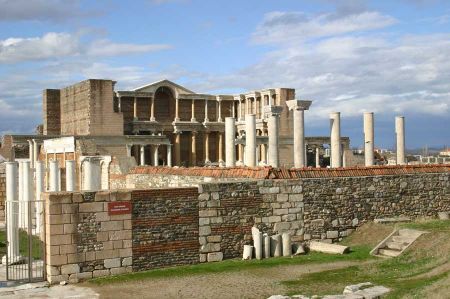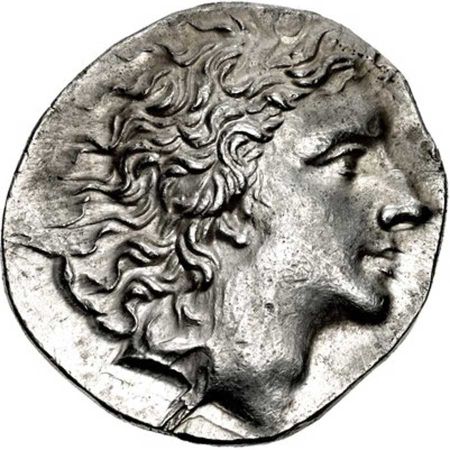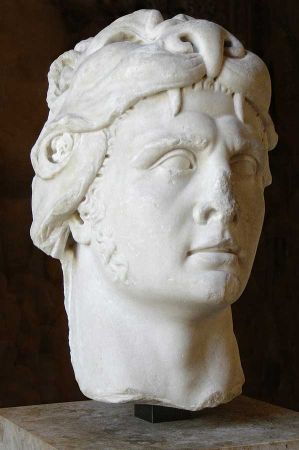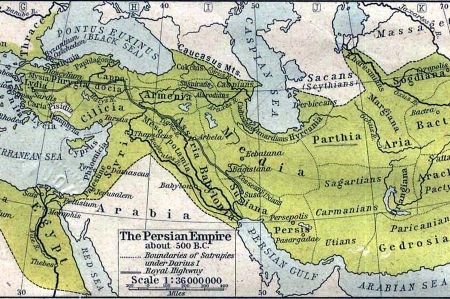Mythologies from Kelainai during the reign of King Midas
- Written by Portal Editor
In our article on the dynasty of the ancient Persian Achaemenids, we reported on the development of the ancient city of Kelainai, which was later called Apameia Kibotos and was located at the sources of the Meander river.
Many legends and myths still circulate today about the once fabulous world of the Phrygians and their King Midas. According to various sources, Kelainai was the capital of the Phrygian Empire under King Midas, who, as a son of Gordios and Cybele, entered the myths of antiquity more out of stupidity and greed.
In order to attain the wisdom of Silenus, Midas believed that it would be enough if he caught him. So Midas tried a trick. He mixed a spring in the forest, which he knew that Silenos used, with wine, so that he fell asleep intoxicated at the spring. When Dionysus heard of the misfortune of his old teacher Silenus, he had to grant Midas a wish in return for the release of Silenus: everything that Midas touched should turn into gold on the spot.
Gold nuggets in the river Paktalos
 As the king wished, it happened, but all dishes immediately turned to gold, which is why Midas was very hungry. He then asked Dionysus to withdraw the wish. As the only possibility for conversion, Dionysus then recommended to the king to bathe in the river Paktalos (today Sart Çayı), so that the gift of "converting gold" could be transferred to the river and thus to the river god Paktalos. Based on this anecdote, the river became the gold-richest river in Asia Minor, because from then on it carried gold nuggets with it, which, according to mythology, ensured the wealth of the ancient city of Sardes and thus the legendary wealth of the Lydian king Croesus, who resided in Sardes. This is how the historian Plutarch, who lived from 46 - 125 AD, reports on the Chrysorrhoas river ("the gold leader") in his notes.
As the king wished, it happened, but all dishes immediately turned to gold, which is why Midas was very hungry. He then asked Dionysus to withdraw the wish. As the only possibility for conversion, Dionysus then recommended to the king to bathe in the river Paktalos (today Sart Çayı), so that the gift of "converting gold" could be transferred to the river and thus to the river god Paktalos. Based on this anecdote, the river became the gold-richest river in Asia Minor, because from then on it carried gold nuggets with it, which, according to mythology, ensured the wealth of the ancient city of Sardes and thus the legendary wealth of the Lydian king Croesus, who resided in Sardes. This is how the historian Plutarch, who lived from 46 - 125 AD, reports on the Chrysorrhoas river ("the gold leader") in his notes.
Another story in mythology says that the god Zeus Idaios opened an abyss in Kelainai, in which several houses and their inhabitants were "swallowed up". After questioning an oracle, Midas learned that this abyss would only close again when Midas would throw his most important asset into it. In the end, the son of King Midas Anchurus and his horse plunged into the abyss, which immediately closed again, whereupon Midas had a temple dedicated to the god Zeus Idaios built on the site.
Mythology aboutdonkey ears
 In a contest between the shapely Apollo and the ugly Pan, King Midas declared Pan the winner. This made Apollon incomprehensible and protest against King Midas, for whom he stretched his ears so that they looked like donkey ears. King Midas was able to cover up this disgrace under a large cap, but he did not want to face anyone without a cap. One day the accident happened and the barber discovered the donkey ears. Although condemned to secrecy by Midas, the barber could not long suppress his proverbial and already well-known talkativeness. Following his inner compulsion, the barber dug a hole on the river bank into which he shouted three times: "King Midas has dog-ears" and then filled the hole again. However, the reeds had listened carefully to the surroundings and did not hesitate to pass the knowledge on to the rushes immediately. In this way, the whole world quickly learned about it.
In a contest between the shapely Apollo and the ugly Pan, King Midas declared Pan the winner. This made Apollon incomprehensible and protest against King Midas, for whom he stretched his ears so that they looked like donkey ears. King Midas was able to cover up this disgrace under a large cap, but he did not want to face anyone without a cap. One day the accident happened and the barber discovered the donkey ears. Although condemned to secrecy by Midas, the barber could not long suppress his proverbial and already well-known talkativeness. Following his inner compulsion, the barber dug a hole on the river bank into which he shouted three times: "King Midas has dog-ears" and then filled the hole again. However, the reeds had listened carefully to the surroundings and did not hesitate to pass the knowledge on to the rushes immediately. In this way, the whole world quickly learned about it.
This ancient Greek parable is still used today when a well-known fact is passed on like a secret: the "secret" had become a truism.
According to another myth, the legendary Mount Ararat is said to be located near Kelainai, where Noah's Ark was once stranded. This can be read in the Sibylline oracle and also in Julius Africanus. Strangely enough, images of Noah's Ark can be found on a large number of found coins from Apamea / Kelainai. Today we know that Mount Ararat is located elsewhere. Since a large number of Jewish believers lived in Apamea, it is more likely to be a local tradition.
The legend about the competition between Apollon and Marsyas
 After the beheading of the Gorgon Medusa, the goddess Athena invented the double flute aulos and learned to play it. Athena was thus able to imitate the melody of the lamentation for the dead of Euryales, a sister of Medusa. When Athena looked into her reflection in the water during the game, she realized that her face was badly consumed due to the strain of playing the double flute. She quickly threw the flute away.
After the beheading of the Gorgon Medusa, the goddess Athena invented the double flute aulos and learned to play it. Athena was thus able to imitate the melody of the lamentation for the dead of Euryales, a sister of Medusa. When Athena looked into her reflection in the water during the game, she realized that her face was badly consumed due to the strain of playing the double flute. She quickly threw the flute away.
The river god Marsyas, who traveled through Phrygia with Cybele, found the aulos, learned how to use them and challenged Apollo to a competition. The muses who attended this competition as a court of arbitration initially saw Marsyas as the winner. But when Apollon added the singing to the game on his kithar, the muses determined Apollon to be the winner. As punishment for the challenge of a god, Apollon hung the Marsyas on a spruce tree, which, as the sacred tree of the Cybele, was supposed to have a particularly humiliating effect, and peeled off his skin while he was still alive. The river Marsyas is said to have sprung from the flowing blood.
Palaephatus reports: “I myself saw the river in Phrygia which is named after him. And the Phrygians say that the river arose from the blood of Marsyas. "
Herodotus (5th century BC) knows 7:26: “The skin of the satyr Marsyas also hangs in the city of Kelainai. According to the legend, the Phrygians took Apollo from Marsyas and hung it here. "
Xenophon (4th century BC), anab. 1,2,8: “Here Apollo is said to have peeled off the skin of Marsyas after he defeated him in a competition and hung it in the spring grotto. That is why the river is called Marsyas".
Please read as well:
The Lion- and the Snake stone in Phrygian Valley
